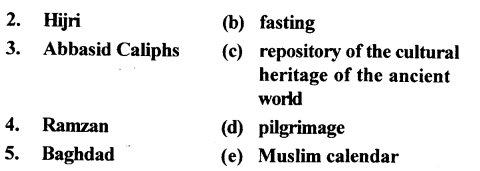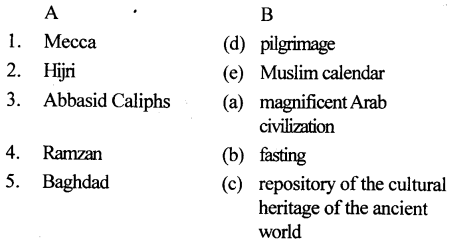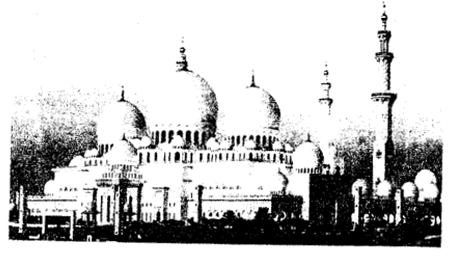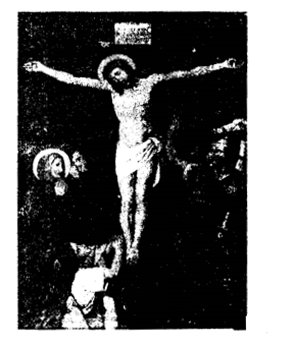The Trail History and Civics for Class 7 ICSE Solutions – Birth of Prophet Muhammad and Spread of Islam
ICSE SolutionsSelina ICSE SolutionsML Aggarwal Solutions
Trail HistoryCivics Focus on HistoryCivicsGeographyMathsPhysicsChemistryBiology
EXERCISE
A. Fill in the blanks :
- Prophet Muhammad, the founder of Islam, was born in Mecca in the year 570 CE.
- Muhammad forbade idol worship and stressed the importance of God and kind behaviour.
- The two holy places of the Muslims are Mecca and Medina.
- Muhammad was succeeded by Abu Bakr, who was known as Caliph. He transformed the Arabs into an excellent fighting force and inspired them to cany the word of Allah throughout the world.
- The first Arab expedition to India took place in 712 CE under the leadership of Muhammad bin Qasim.
B. Match the following :


Answer:

C. Choose the correct answer :
1. As a young man, Muhammad worked as a trader/farmer/ craftsman.
Ans. As a young man, Muhammad worked as a trader.
2. During Muhammad’s time, the Arabs were divided into a number of kingdoms/tribes/empires.
Ans. During Muhammad’s time, the Arabs were divided into a number of tribes.
3. Muslims must say their prayers four/five/six times a day.
Ans. Muslims must say their prayers five times a day.
4. The Abbasid Caliphs shifted the Caliphate from Damascus to Medina/Mecca/Baghdad.
Ans. The Abbasid Caliphs shifted the Caliphate from Damascus to Baghdad.
5. The Arab traders established trade settlements on the eastern/western/southern coast of India.
Ans. The Arab traders established trade settlements on the western coast of India.
D. State whether the following are true or false :
1. The Medieval Period in India stretches from the 8th century CE to the 16th century CE.
Ans. False.
Correct : The Medieval Period in India stretches from the 8th century CE to the 18th century CE.
2. Before the rise of Islam, the Arabs practiced idol worship.
Ans. True.
3. The Arab empire under the Abbasid Caliphs was one of the most powerful and enlightened regions in the world.
Ans. True.
4. The occupation of Sind ended with the death of Muhammad bin Qasim.
Ans. True.
5. In the 9th century CE, the power of the Caliphs declined.
Ans. True.
E. Answer the following questions in one or two words/sentences :
Question 1.
Where was Prophet Muhammad born?
Answer:
Prophet Muhammad was born in Mecca
Question 2.
What important event took place in Muhammad’s life around 610 CE?
Answer:
When Muhammad was about forty years old, he had a vision of God, who revealed to him the divine message, to carry the word of God or Allah to the people of Mecca. He declared that Allah was the one and only God and Muhammad was his Prophet. This gave way to a new religion called Islam.
Question 3.
What does the term Hijrat mean?
Answer:
Hijrat marks the departure of Prophet Muhammad from Mecca to Medina in 622 CE.
Question 4.
What title did Abu Bakr assume after he succeeded Prophet Muhammad?
Answer:
Abu Bakr took the title of Khalifa or Caliph.
Question 5.
Under whose reign did the Arabs achieve their greatest heights of intellectual and cultural excellence?
Answer:
The greatest intellectual and cultural excellence was seen during the reign of the Abbasid Caliphs.
Question 6.
Why was the House of Wisdom established?
Answer:
The house of Wisdom was set up in Baghdad as it was advised by Prophet Muhammad to pursue learning among Arabs. So Baghdad become the place of wisdom where various ancient civilizations such as Greek, Byzantine, Egyptian, Chinese, Indian and Persian were translated into Arabic.
Question 7.
Which Arab city became the preserve of the rich cultural heritage of the ancient world?
Answer:
Baghdad became the repository and preserve of the rich cultural heritage of the ancient world.
Question 8.
What were the chief items of export and import in India’s trade relations with the Arabs?
Answer:
The chief items of export during India’s trade relations with the Arabs were Pepper, Muslin, Indigo etc. and import were luxury items and fine Arabian horses.
Question 9.
Why were the Indians not receptive to Arab learning and civilization during this period?
Answer:
The spirit of exclusiveness among the Hindus made them reject foreign cultural influence. The Hindus believed that no other country on earth but theirs had any knowledge of Science. Hence, they were not receptive to the rich treasures of Arabic learning and civilization.
Question 10.
Name any one independent state established by the Turks in Central Asia.
Answer:
Two independent states established by the Turks in Central Aisa were Ghazni and Ghor.
F. Answer the following questions briefly :
Question 1.
Why did Muhammad shift from Mecca to Medina? Discuss the events that followed this move.
Answer:
Muhammad forbade idol worship and stressed the importance of good and kind behaviour. His teachings angered the rich Arabs, and Muhammad and his small band of followers were forced to shift to Medina in 622 CE. Muhammad’s move from Mecca to Medina is known as Hijrat.
Question 2.
State the main principles of Islam.
Answer:
The main principles of Islam:
- There is only one God and Muhammad is his Prophet.
- Muslims must turn towards Mecca and say their prayers five times a day.
- They must fast from dawn to dusk during the holy month of Ramzan.
- They must help the poor and needy by giving away a portion of their wealth in charity.
- They must make a pilgrimage to Mecca at least once in their lifetime.
Question 3.
The greatest intellectual and cultural excellence was seen during the reign of the Abbasid Caliphs. Discuss.
Answer:
The Abbasids shifted the Caliphate from Damascus to Baghdad (capital of modem Iraq). For the next 150 years, the Arab empire under the Abbasids emerged as one of the most powerful, prosperous and enlightened regions in the world. The Arabs absorbed and assimilated the best of what other cultures and civilizations had to offer in terms of ideas, skills and scientific knowledge.Muhammad had advised the Arabs to pursue learning. One of the Abbasid Caliphs established a House of Wisdom at Baghdad to translate into Arabic the collective wisdom of various ancient civilizations such as the Greek, Byzantine, Egyptian, Chinese, Indian and Persian civilizations. Baghdad became the repository and preserve of the rich cultural heritage of the ancient world.
Question 4.
What knowledge did the Arabs gather from
(a) Indian
(b) various other ancient civilizations?
Answer:
(a) The Arabs, learnt a great deal from the ancient Indian civilization. Knowledge of Indian mathematics, medicine, astronomy, philosophy and the art of administration were assimilated by the Arabs, leading to further enrichment of the Arab civilization and culture.
(b) Knowledge absorbed and assimilated by Arab scholars from different civilizations
- Chinese : (a)Art of paper making, (b) Glass making techniques, (c) Use of mariner’s compass.
- Greeks : (a) Geometry.
- Persians : (a) Astronomy.
- Indians : (a) Mathematical theories, (b) medicine, (c) Astronomy, (d) Philosophy, (e) Administration.
G Picture study :
This is a picture of a mosque where Muslims go to pray (picture on next page).
Question 1.
Name :
(a) their religion
(b) their holy book
(c) the founder of their religion.
Answer:
(a) Islam
(b) Quran Sharif
(c) Prophet Muhammad.
Question 2.
Name the two holy places of the Muslim.
Answer:
(a) Mecca
(b) Medina

Question 3.
Why does the Muslim calendar begin from the year 622 CE?
Answer:
Muhammad and his small band of followers were forced to flee to Medina in 622 CE. Muhammad’s departure from Mecca to Medina is known as hijrat. The Muslim calendar, hijri, begins from that year.
Question 4.
Mention any four important principles of the religion.
Answer:
The main four principles of Islam are as follows :
- There is only one God and Muhammad is His Prophet.
- Muslims must say their prayers five times a day.
- They must help the poor and needy by giving away a portion of their wealth in charity.
- They must make a pilgrimage to Mecca at least once in their lifetime.
Question 5.
Briefly describe the role of Abu Bakr in the spread of the this religion.
Answer:
Abu Bakr mobilized and transformed the Arabs into an excellent fighting force. He and his successors inspired the Arab armies to sweep across countries and continents and carry the word of Allah throughout the world. Inspired by missionary zeal, these invincible and extraordinary Arab armies conquered vast territories. Their empire stretched over Iran, Syria, Central Asia, North Africa and Spain.
OTHER IMPORTANT QUESTIONS
Question 1.
What is the importance of the year 622 OK in the history of Islam?
Answer:
In the year AD 622 Muhammad and his small band of followers were forced to flee to Medina, due to their teachings which angered the rich Arabs. There in Medina people welcomed them and within ten years Muhammad won considerable support. His supporters included a small but devoted army which was ready to lay down their lives for the sake of Islam.
Question 2.
How did the Arabs enrich their knowledge?
Answer:
Arabs enriched their knowledge a great deal from the ancient Indian civilization. Knowledge of Indian mathematics, medicine, astronomy, philosophy and the art of administration was assimilated by the Arabs, leading to enrichment of the Arab civilization and culture.







